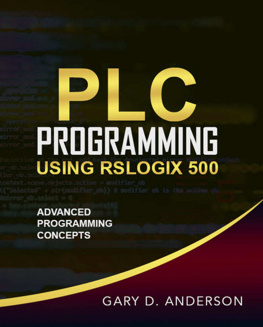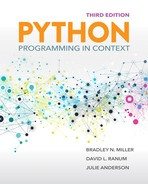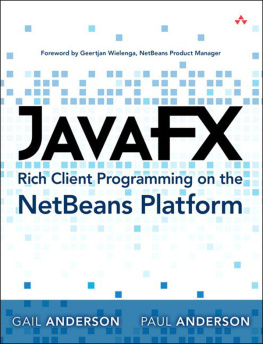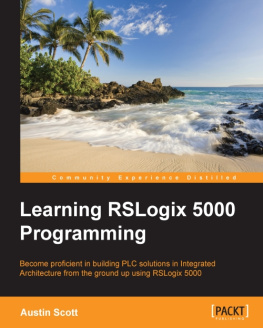Anderson - PLC Programming Using RSLogix 500
Here you can read online Anderson - PLC Programming Using RSLogix 500 full text of the book (entire story) in english for free. Download pdf and epub, get meaning, cover and reviews about this ebook. year: 2020, genre: Home and family. Description of the work, (preface) as well as reviews are available. Best literature library LitArk.com created for fans of good reading and offers a wide selection of genres:
Romance novel
Science fiction
Adventure
Detective
Science
History
Home and family
Prose
Art
Politics
Computer
Non-fiction
Religion
Business
Children
Humor
Choose a favorite category and find really read worthwhile books. Enjoy immersion in the world of imagination, feel the emotions of the characters or learn something new for yourself, make an fascinating discovery.
- Book:PLC Programming Using RSLogix 500
- Author:
- Genre:
- Year:2020
- Rating:4 / 5
- Favourites:Add to favourites
- Your mark:
- 80
- 1
- 2
- 3
- 4
- 5
PLC Programming Using RSLogix 500: summary, description and annotation
We offer to read an annotation, description, summary or preface (depends on what the author of the book "PLC Programming Using RSLogix 500" wrote himself). If you haven't found the necessary information about the book — write in the comments, we will try to find it.
PLC Programming Using RSLogix 500 — read online for free the complete book (whole text) full work
Below is the text of the book, divided by pages. System saving the place of the last page read, allows you to conveniently read the book "PLC Programming Using RSLogix 500" online for free, without having to search again every time where you left off. Put a bookmark, and you can go to the page where you finished reading at any time.
Font size:
Interval:
Bookmark:
PLC Programming Using RSLogix 500
Advanced Programming Concepts
Book 2
By
Gary D. Anderson
PLC Programming using RSLogix 500
Advanced Programming Concepts (Book 2)
Copyright 2015 Gary D. Anderson
All Rights Reserved.
Every effort has been made in preparation of this book to ensure accuracy in presenting these concepts, information, and the typical usage of instructions when programming in the RS Logix 500 development platform. The information contained herein is sold without any expressed or implied warranty.
First Published: June 2015
PLC Programming using RSLogix 500: Advanced Programming Concepts
ISBN: 978-1-7341898-6-5
Contents
The Instructions
In my previous book, Basic Concepts of PLC Programming, I focused on many of the basic programming instructions, concepts, and their use in ladder logic programs. These instructions included the (XIC), the (XIO), and the (OTE) - including the (OTL) latching and (OTU) unlatch instructions. Also covered, were timer and counter instructions, the use of the OSR or one-shot-rising instruction, and the MCR instruction. These will also be shown by example and covered in more detail in this book, since they are the principle building blocks of any ladder logic routine.
In Advanced Concepts, we will look into the use of many other specialized instructions, such as the (RTO) retentive timer, the use of the (RES) reset instruction, and counters, which are also utilized in a wide array of applications. Also in the following chapters, we will discuss register type instructions that accomplish functions such as data comparisons or manipulation, by using entire words of data, either 16 or 32 bits. Ill also cover the basic math instructions that can be used in scaling for analog values, and some discussion on instructions that provide program flow to subroutines.
Hopefully by this time, youve reached some degree of a comfort zone in addressing the instructions we talked about in the Basics book. In this second book Ill not spend much time covering those topics again unless it is to focus on some variation not covered by the syntax chart included in the first book.
The focus for this volume should accomplish the following objectives:
- To understand the use of RSLinx drivers and basic communication protocols.
- To understand fully the use of timers the TON, TOF, RTO and the use of the reset (RES) instructions.
- To understand the use of counters the CTU and CTD, and the way in which counters and timers are often nested together to develop a specific time-base for scheduled maintenance or other process related issues.
- To understand the use of register instructions such as the MOV, CLR, COP and FLL.
- To understand the use of the math instructions: ADD, SUB, MUL, DIV & DDIV.
- To understand comparison and program flow instructions.
- To better understand analog scaling, what it means, and different ways of accomplishing scaling within your ladder logic program including the use of the math instructions, the SCL, and the SCP instructions.
- One thing I have decided to include, and in fact begin in the following chapter, is a brief discussion with examples on using RSLinx and its related communication protocols, drivers and physical media. Communication between your interface devices, such as a laptop, can sometimes be a troublesome issue. So I think its important to address the whole issue of connectivity at the beginning of our programming experience. Ive also included the driver & cable chart that was shown in book 1, simply because its a good reference to have handy, and has worked well for me.
The SLC 500 family of processors is basically composed of the following models: the 5/01, 5/02, 5/03, 5/04 and the 5/05, although I seldom see 5/01s or /02s anymore. Still, the 5/03s and newer are still very much in use, and in my opinion, a good programming tool for many applications. Each of these employ one or two different channels where the interface device cable may be connected. The communication channels are slightly different from model-to-model so its necessary understand the different Allen-Bradley communication protocols used for each model of processor. The 5/01 and 5/02 had only a single communication channel, while the 5/03, 5/04, and 5/05 have two channels designated channel 0 and channel 1.
Following are the basic Rockwell Automation /Allen-Bradley communication protocols, and a brief description of each. Then we can consider the channels and their default settings for these five different processors. As you will see, these same communication protocols are used with other Allen Bradley processors, such as the PLC-5 models, the Micrologix processors, and also the ControlLogix and CompactLogix processors which use the RSLogix 5000 application software.
Understanding the difference between a protocol, and the language that surrounds the descriptions of physical media wiring and connection types, can at times be confusing because many of the terms are used interchangeably. For example, someone may simply say that they are using a RS-232 driver, but technically this refers to the physical media rather than the drivers or protocol which would be the DF-1. Therefore, its a good idea to at least define what a protocol is, because it may work with several different types of network connections and wiring. A specific processor channel may work with several different drivers and configurations as well.
A communications protocol is simply a set of established rules for exchanging data between computers or other electronic devices, such as a PLC processor. These rules define details pertaining to the syntax used, data and addressing formats, types of flow control, sequencing and size of the data frame, error detection, acknowledgements, time-out periods, and many other important details.
Physical characteristics of networks, on the other hand, will be designated as RS-232, RS-422, RS-485 or Ethernet. Perhaps more importantly, these network types will be defined by those standards which specify different physical characteristics in terms of voltage, wiring, the number of nodes or devices that can be accommodated, the length of cable runs, as well as the speed and throughput of data transmission.
To illustrate the physical context of the RS-232 standard (EIA/TIA-232); it defines the voltage levels for what will be interpreted as a logic 1 and 0 during data transmission. The specified voltage range for a logic 1 is a voltage pulse between negative (-3) and negative (-25) volts; a logic 0 voltage is between (+3) and (+25) volts. Protocols are designed to work with each of the physical characteristics defined by these standards. The channel connections Allen Bradley builds into their processors are configured to work with the following protocols:
This protocol supports the EIA/TIA-232 standard. For this reason it is usually thought synonymous with RS-232 and serial communication, and supports data transmission rates of up to 19.2K baud, or 19,200 bits/s. It supports full-duplex peer-to-peer communication, sometimes referred to as point-to-point where two devices can communicate simultaneously, and also half-duplex communication where devices take turns sending and receiving data in a master / slave type of network.
This is Allen Bradleys Data Highway protocol, and is used for RS-485 communication (EIA/TIA-485). Once again; just as with RS-232, the RS-485 standard defines the physical characteristics detailing wiring media and other electrical properties.
The DH-485 protocol is designed for use with the RS-485 standard. A DH-485 network is a LAN (local area network), designed for multi-point connections, and used in industrial applications where electrical noise may be a problem. These networks allow connection of up to 32 nodes or devices, such as PLC controllers, HMIs and personal computers. As such, this protocol uses a multi-master, token-passing scheme which allows all the devices on the DH-485 network to have a turn in sending and receiving data. This protocol supports baud rates of up to 19.2K using Beldon 9842 or 3106A cable with RS-485 specifications.
Next pageFont size:
Interval:
Bookmark:
Similar books «PLC Programming Using RSLogix 500»
Look at similar books to PLC Programming Using RSLogix 500. We have selected literature similar in name and meaning in the hope of providing readers with more options to find new, interesting, not yet read works.
Discussion, reviews of the book PLC Programming Using RSLogix 500 and just readers' own opinions. Leave your comments, write what you think about the work, its meaning or the main characters. Specify what exactly you liked and what you didn't like, and why you think so.


















